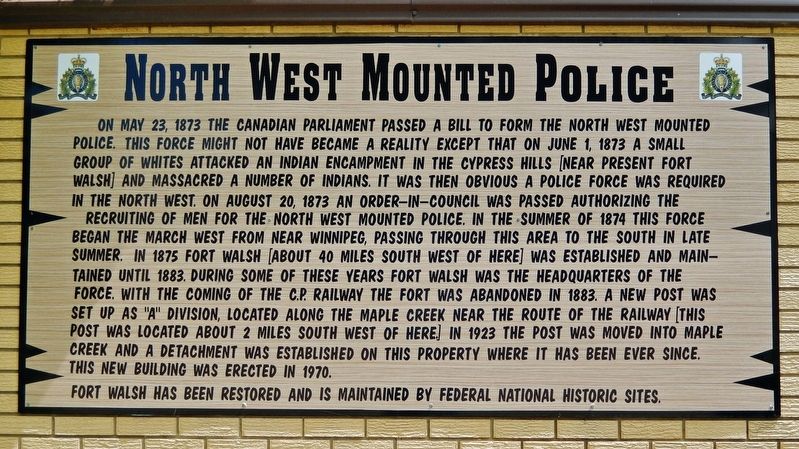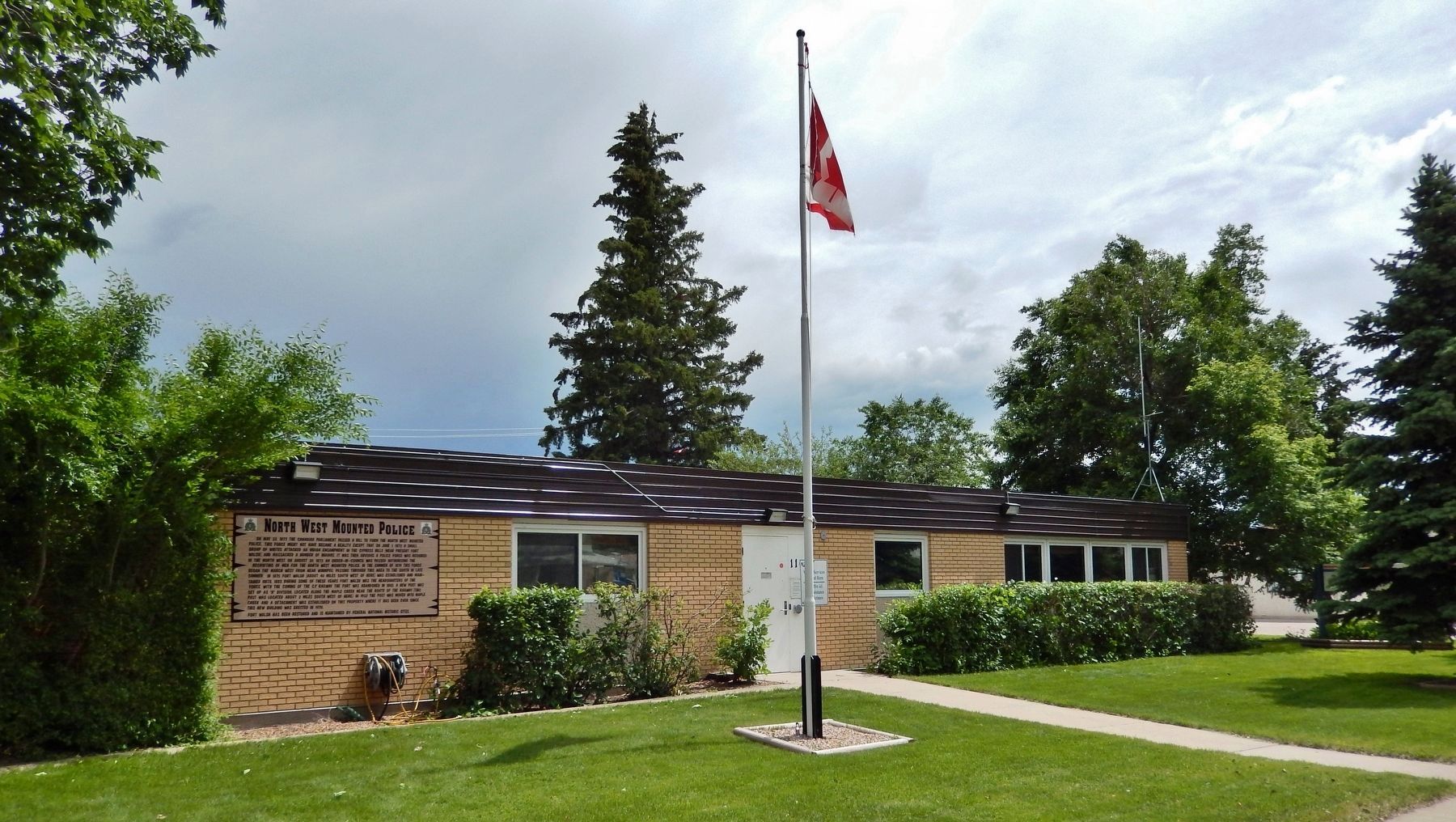Maple Creek in Maple Creek No. 111, Saskatchewan — The Prairie Region (North America)
North West Mounted Police
On May 23, 1873 the Canadian Parliament passed a bill to form the North West Mounted Police. This force might not have became a reality except that on June 1, 1873 a small group of whites attacked an Indian encampment in the Cypress Hills [near present Fort Walsh] and massacred a number of Indians. It was then obvious a police force was required in the North West. On August 20, 1873 an Order-in-Council was passed authorizing the recruiting of men for the North West Mounted Police. In the summer of 1874 this force began the march west from near Winnipeg, passing through this area to the south in late summer. In 1875 Fort Walsh [about 40 miles south west of here] was established and maintained until 1883. During some of these years Fort Walsh was the headquarters of the force. With the coming of the C.P. Railway the fort was abandoned in 1883. A new post was set up as “A” Division, located along the Maple Creek near the route of the railway [this post was located about 2 miles south west of here.] In 1923 the post was moved into Maple Creek and a detachment was established on this property where it has been ever since. This new building was erected in 1970.
Fort Walsh has been restored and is maintained by Federal National Historic Sites.
Topics. This historical marker is listed in these topic lists: Forts and Castles • Law Enforcement • Native Americans • Railroads & Streetcars. A significant historical date for this entry is May 23, 1873.
Location. 49° 54.509′ N, 109° 28.8′ W. Marker is in Maple Creek, Saskatchewan, in Maple Creek No. 111. Marker is on Maple Street just north of 1 Avenue, on the right when traveling north. Marker is mounted at eye-level on the front/west wall of the Maple Creek Royal Canadian Mounted Police Station. Touch for map. Marker is at or near this postal address: 110 Maple Street, Maple Creek SK S0N 1N0, Canada. Touch for directions.
Other nearby markers. At least 1 other marker is within walking distance of this marker. Maple Creek Cenotaph (about 120 meters away, measured in a direct line).
Also see . . .
1. North-West Mounted Police.
The North-West Mounted Police (NWMP) was the forerunner of Canada's iconic Royal Canadian Mounted Police. Created after Confederation to police the frontier territories of the Canadian West, the NWMP ended the whiskey trade on the southern prairies and the violence that came with it, helped the federal government suppress the North-West Rebellion, and brought order to the Klondike Gold Rush. The NWMP pioneered the enforcement of federal law in the West, and the Arctic, from 1873 until 1920.(Submitted on July 23, 2022, by Cosmos Mariner of Cape Canaveral, Florida.)
2. North-West Mounted Police.
The North-West Mounted Police was a Canadian para-military police force, established in 1873, to maintain order in the new Canadian North-West Territories. In 1874, the NWMP were deployed to the area of the present Alberta border. Their ill-planned and arduous journey of nearly 900 miles became known as the March West and was portrayed as an epic journey of endurance. Over the next few years, the NWMP established a wide network of forts, posts and patrols and extended Canadian law across the region. The living conditions of the NWMP on the prairies were spartan and often uncomfortable, and only slowly improved over the course of the century.(Submitted on July 23, 2022, by Cosmos Mariner of Cape Canaveral, Florida.)
3. Fort Walsh.
Fort Walsh was built in June 1875 and was named for its builder, inspector James Morrow Walsh. The fort was intended to curb the illegal whiskey trade, protect Canada's nearby border with the United States, and aid with native policy. These factors had been brought to public attention following the Cypress Hills Massacre of 1873 and resulted in Prime Minister John A. Macdonald's establishment of the NWMP.(Submitted on July 23, 2022, by Cosmos Mariner of Cape Canaveral, Florida.)
Credits. This page was last revised on July 23, 2022. It was originally submitted on July 23, 2022, by Cosmos Mariner of Cape Canaveral, Florida. This page has been viewed 184 times since then and 31 times this year. Photos: 1, 2. submitted on July 23, 2022, by Cosmos Mariner of Cape Canaveral, Florida.

